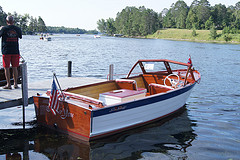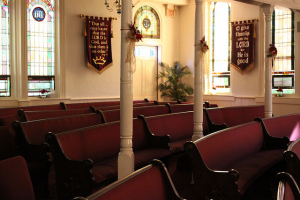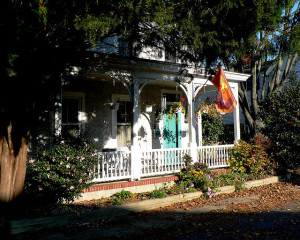How to make a custom flag

So you’ve drawn Uncle Jimmy’s name for the Christmas gift exchange and he’s got a cool new boat that is just begging for a custom boat flag. Now what?
Well, there are a few things to consider before you hit the fabric store.
Flag Use
If a flag is to be used outdoors (as most are) then you’ll want to choose a fabric that will hold up. Typically a nylon or polyester fabric is preferable to something natural, such as cotton, because it will dry faster and resist mold. This is especially important in a damp environment, like on a lake or on the coast.

If your flag is to be used indoors, then you’ll be able to choose from a wider range of fabrics. These are sometimes called banners or tapestries since they aren’t flapping in the breeze.
Your fabric choice will have an impact on how easy it is to make your new flag. Stretchy or flimsy fabrics are harder to sew. Also, if you’re planning to print on the fabric, then your printing process may require a certain fabric.
Flag Size
You’ll certainly want to know how large the flag should be before buying fabric. Once you know the size, buy a little extra fabric for the hems on each side and the end of the flag. These hems are what will keep your flag from being destroyed by the wind.
Unless Uncle Jimmy has a large yacht, you’ll probably want to go with a 12×18” flag. Larger personal boats may use a flag as large as 16×24”, but they are usually no larger than that.
For a flag that’s going to fly on a flagpole, here’s a handy flag sizing guide. Keep in mind that this guide is for a single flag on a flagpole, or the largest one if there are multiple flags. If you’re flying something above your new custom flag, you’ll want to scale down the size of your custom flag.

House mounted flags range from 2×3′ to 3×5′ usually, and garden flags are 11×15″ or 12×18.
Construction Method
Some flags are “Single-Sided”. This means less work when you’re making it, but it also means that anyone viewing the flag from the back side won’t get the same experience as somebody in front of it. This is great for an indoor banner or tapestry.
“Single-Reverse” is a term used to describe a flag that shows correct on the front and backwards on the back. This is typical for most state flags or country flags. If you’ve got a simple design or want a lightweight flag to float in the breeze, then this if for you.
“Double-Sided” flags are about double the work (and double the fabric) but can be more durable than their counterparts.
This is a great option for a flag that is going to be on a boat or vehicle. Remember to pick up a white lining fabric to go between the front and back of your flag. This will keep your image from showing through the back when you’re looking at the front.
Mounting
There are 2 typical mounting methods for most flags today. The most common for outdoor flags is grommets. These are the little metal eyelets that you see on the edges of a tarp. They reinforce holes in the fabric so that a clip can be used without ripping your hard work. The other option is a sleeve. You’ve seen a similar set-up at to top of most window curtains. This is common for indoor banners or house-mounted flags. The sleeve is made large enough to accommodate the flagpole that you want to use. For a house mounted flag with a pole sleeve you’ll need a tab with a button hole in it for attaching it to the pole. This can be accomplished with fabric but can also be purchased ready-made.
Design Method
How do you want to create your design? Flags are usually either printed or sewn.
To print on your flag, you can use a heat transfer method, similar to making a t-shirt or screen print.
A sewn flag is typically done in an “appliqué” process. This entails sewing a new piece of fabric over the background using a satin stitch to protect the cut edges of the new fabric. This is best for a simple design but a talented sewer can create a very rich look with this process.
Step 1
Hit the store. Find the fabric and mounting hardware that you’ll need based on the options that you’ve chosen above. You can also purchase a bag of flag nylon to get you started.
Step 2
Cut your background fabric. Leave an inch or more for your hems to make a good, strong finished product.
Step 3
Create your design. Print or appliqué onto your background fabric. This could be single-sided or single-reverse, which are both just one layer of fabric. Your other option is double-sided, which ends up being 3 pieces of fabric (2 panels with your design — reading correctly on both sides — plus your liner).
Step 4
Hem your flag to finish the edges. Turn over each edge so that the raw fabric edge is inside the roll and sew 2 or more rows of stitching to hold things in place. Don’t forget your liner if you’re doing a double-sided flag.
Step 5
Add your mounting. If you’re using a pole sleeve method, you’re just going to take one end and create a pocket like on a window curtain. For a house mounted flag with a pole sleeve, you’ll need to add your tab to the end that stays closest to the top end of your flagpole. For a grommet flag you’ve got 2 options. You can add a “header” material which is a stronger canvas, to the end of your flag, and punch the grommet through it. The other option is to roll over a thick section of fabric, creating a few layers to punch your grommets through. Add a grommet to each end of your header (or reinforced end)
Congratulations!
You’ve got a finished flag for Uncle Jimmy!
If this all sounds a bit complicated, we’d be happy to make your new custom flag for you. Here’s a few ways to start that process.
Call one of our knowledgeable staff members at 1-888-697-3524
Email our sales department at [email protected]
Submit a quote request form


I found it interesting to learn that most flags are single sided. The thought had never really occurred to me to have a double sided flag. I found it interesting that a double-sided flag would be used for more rough conditions. I will probably need to make a double-sided because I want to use it for my boat.